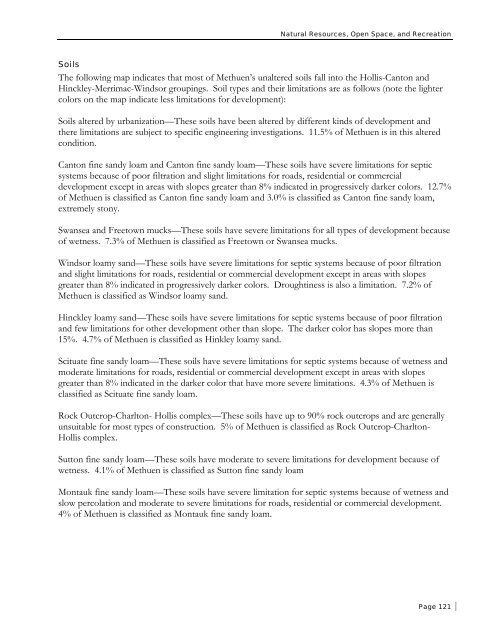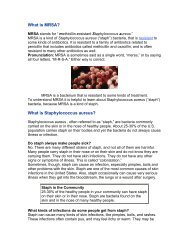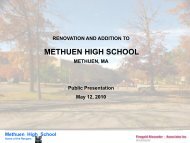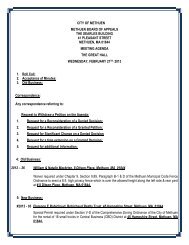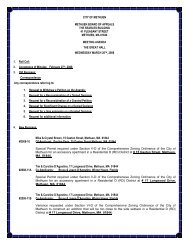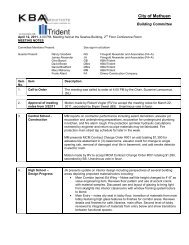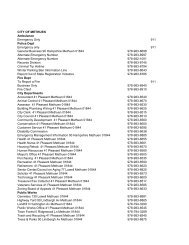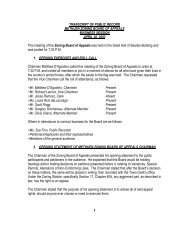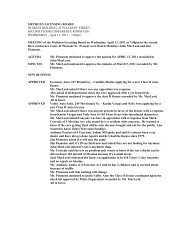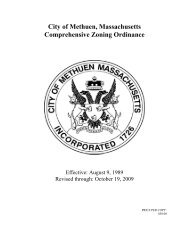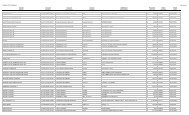City of Methuen Master Plan
City of Methuen Master Plan
City of Methuen Master Plan
Create successful ePaper yourself
Turn your PDF publications into a flip-book with our unique Google optimized e-Paper software.
Natural Resources, Open Space, and Recreation<br />
Soils<br />
The following map indicates that most <strong>of</strong> <strong>Methuen</strong>’s unaltered soils fall into the Hollis-Canton and<br />
Hinckley-Merrimac-Windsor groupings. Soil types and their limitations are as follows (note the lighter<br />
colors on the map indicate less limitations for development):<br />
Soils altered by urbanization—These soils have been altered by different kinds <strong>of</strong> development and<br />
there limitations are subject to specific engineering investigations. 11.5% <strong>of</strong> <strong>Methuen</strong> is in this altered<br />
condition.<br />
Canton fine sandy loam and Canton fine sandy loam—These soils have severe limitations for septic<br />
systems because <strong>of</strong> poor filtration and slight limitations for roads, residential or commercial<br />
development except in areas with slopes greater than 8% indicated in progressively darker colors. 12.7%<br />
<strong>of</strong> <strong>Methuen</strong> is classified as Canton fine sandy loam and 3.0% is classified as Canton fine sandy loam,<br />
extremely stony.<br />
Swansea and Freetown mucks—These soils have severe limitations for all types <strong>of</strong> development because<br />
<strong>of</strong> wetness. 7.3% <strong>of</strong> <strong>Methuen</strong> is classified as Freetown or Swansea mucks.<br />
Windsor loamy sand—These soils have severe limitations for septic systems because <strong>of</strong> poor filtration<br />
and slight limitations for roads, residential or commercial development except in areas with slopes<br />
greater than 8% indicated in progressively darker colors. Droughtiness is also a limitation. 7.2% <strong>of</strong><br />
<strong>Methuen</strong> is classified as Windsor loamy sand.<br />
Hinckley loamy sand—These soils have severe limitations for septic systems because <strong>of</strong> poor filtration<br />
and few limitations for other development other than slope. The darker color has slopes more than<br />
15%. 4.7% <strong>of</strong> <strong>Methuen</strong> is classified as Hinkley loamy sand.<br />
Scituate fine sandy loam—These soils have severe limitations for septic systems because <strong>of</strong> wetness and<br />
moderate limitations for roads, residential or commercial development except in areas with slopes<br />
greater than 8% indicated in the darker color that have more severe limitations. 4.3% <strong>of</strong> <strong>Methuen</strong> is<br />
classified as Scituate fine sandy loam.<br />
Rock Outcrop-Charlton- Hollis complex—These soils have up to 90% rock outcrops and are generally<br />
unsuitable for most types <strong>of</strong> construction. 5% <strong>of</strong> <strong>Methuen</strong> is classified as Rock Outcrop-Charlton-<br />
Hollis complex.<br />
Sutton fine sandy loam—These soils have moderate to severe limitations for development because <strong>of</strong><br />
wetness. 4.1% <strong>of</strong> <strong>Methuen</strong> is classified as Sutton fine sandy loam<br />
Montauk fine sandy loam—These soils have severe limitation for septic systems because <strong>of</strong> wetness and<br />
slow percolation and moderate to severe limitations for roads, residential or commercial development.<br />
4% <strong>of</strong> <strong>Methuen</strong> is classified as Montauk fine sandy loam.<br />
Page 121


